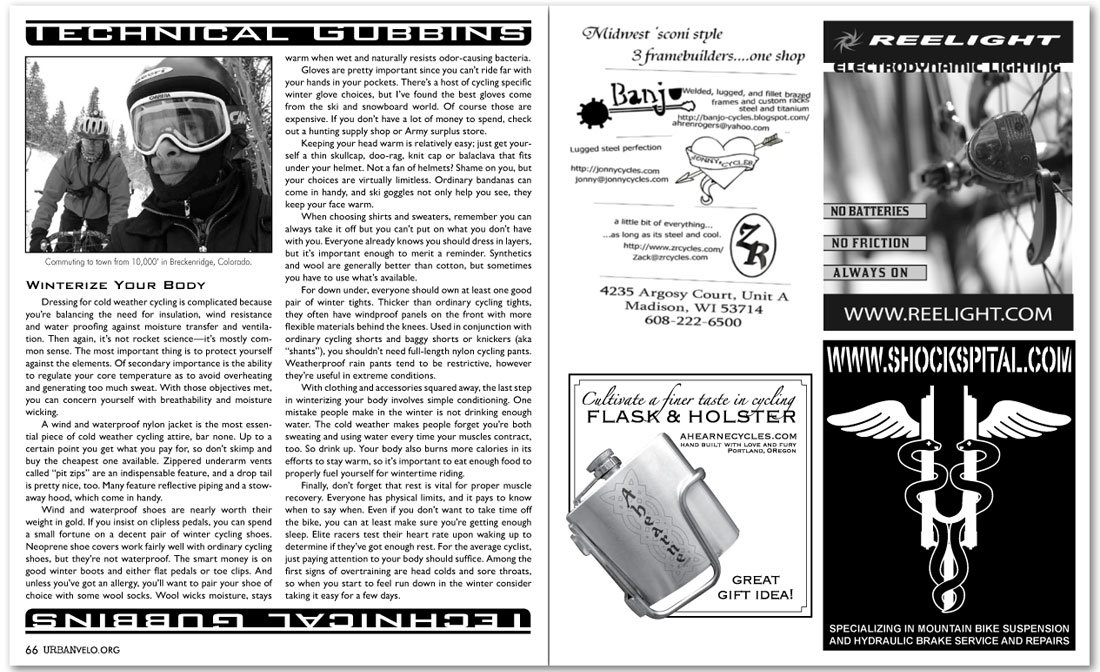

|
|||
Technical Gubbins... continuedWinterize Your Body Dressing for cold weather cycling is complicated because you’re balancing the need for insulation, wind resistance and water proofing against moisture transfer and ventilation. Then again, it’s not rocket science—it’s mostly common sense. The most important thing is to protect yourself against the elements. Of secondary importance is the ability to regulate your core temperature as to avoid overheating and generating too much sweat. With those objectives met, you can concern yourself with breathability and moisture wicking. A wind and waterproof nylon jacket is the most essential piece of cold weather cycling attire, bar none. Up to a certain point you get what you pay for, so don’t skimp and buy the cheapest one available. Zippered underarm vents called “pit zips” are an indispensable feature, and a drop tail is pretty nice, too. Many feature reflective piping and a stowaway hood, which come in handy. Wind and waterproof shoes are nearly worth their weight in gold. If you insist on clipless pedals, you can spend a small fortune on a decent pair of winter cycling shoes. Neoprene shoe covers work fairly well with ordinary cycling shoes, but they’re not waterproof. The smart money is on good winter boots and either flat pedals or toe clips. And unless you’ve got an allergy, you’ll want to pair your shoe of choice with some wool socks. Wool wicks moisture, stays warm when wet and naturally resists odor-causing bacteria. Gloves are pretty important since you can’t ride far with your hands in your pockets. There’s a host of cycling specific winter glove choices, but I’ve found the best gloves come from the ski and snowboard world. Of course those are expensive. If you don’t have a lot of money to spend, check out a hunting supply shop or Army surplus store. Keeping your head warm is relatively easy; just get yourself a thin skullcap, doo-rag, knit cap or balaclava that fits under your helmet. Not a fan of helmets? Shame on you, but your choices are virtually limitless. Ordinary bandanas can come in handy, and ski goggles not only help you see, they keep your face warm. When choosing shirts and sweaters, remember you can always take it off but you can’t put on what you don’t have with you. Everyone already knows you should dress in layers, but it’s important enough to merit a reminder. Synthetics and wool are generally better than cotton, but sometimes you have to use what’s available. For down under, everyone should own at least one good pair of winter tights. Thicker than ordinary cycling tights, they often have windproof panels on the front with more flexible materials behind the knees. Used in conjunction with ordinary cycling shorts and baggy shorts or knickers (aka “shants”), you shouldn’t need full-length nylon cycling pants. Weatherproof rain pants tend to be restrictive, however they’re useful in extreme conditions. With clothing and accessories squared away, the last step in winterizing your body involves simple conditioning. One mistake people make in the winter is not drinking enough water. The cold weather makes people forget you’re both sweating and using water every time your muscles contract, too. So drink up. Your body also burns more calories in its efforts to stay warm, so it’s important to eat enough food to properly fuel yourself for wintertime riding. Finally, don’t forget that rest is vital for proper muscle recovery. Everyone has physical limits, and it pays to know when to say when. Even if you don’t want to take time off the bike, you can at least make sure you’re getting enough sleep. Elite racers test their heart rate upon waking up to determine if they’ve got enough rest. For the average cyclist, just paying attention to your body should suffice. Among the first signs of overtraining are head colds and sore throats, so when you start to feel run down in the winter consider taking it easy for a few days. |
|
|